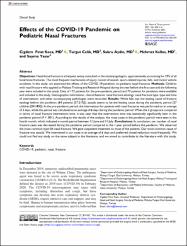| dc.contributor.author | Firat Koca,Ç., Celik,T., Aydin,Ş., Kelles,M., Yasar,Ş. | |
| dc.date.accessioned | 2022-03-10T07:09:22Z | |
| dc.date.available | 2022-03-10T07:09:22Z | |
| dc.date.issued | 23 kasım 2021 | en_US |
| dc.identifier.citation | Firat Koca, C., Celik, T., Aydin, S., Kelles, M., & Yasar, S. (2021). Effects of the COVID-19 Pandemic on Pediatric Nasal Fractures. Ear, Nose & Throat Journal, 01455613211051309. | en_US |
| dc.identifier.uri | DOI: 10.1177/01455613211051309 | |
| dc.identifier.uri | https://hdl.handle.net/20.500.12899/573 | |
| dc.description.abstract | Objectives: Nasal bone fracture is a frequent entity consulted to the otolaryngologists, approximately accounting for 39% of all facial bone fractures. The most frequent mechanisms of injury consist of assault, sport-related injuries, falls, and motor vehicle accidents. In this study, we examined the effects of the COVID-19 pandemic on pediatric nasal fractures. Methods: Children with nasal fracture who applied to Malatya Training and Research Hospital during the year before the first case and the following year were included in this study. Data of 172 patients for the pre-pandemic period and 79 patients for pandemic were available and included in the study. Demographic information, clinical features, nasal fracture etiology, nasal fracture type, type and time of intervention, and other accompanying pathologies were recorded. Results: While falls was the leading cause of fracture etiology before the pandemic (64 patients [37.21%]), assault seems to be the leading cause during the pandemic period (27 children [34.18%]). In the pre-pandemic period, the intervention for patients with nasal fractures was performed on an average
of 5 days, while this period was calculated as an average of 6 days during the pandemic period. When the 2 groups are compared in terms of nasal fracture intervention time, it was seen that the intervention time was statistically significantly later in the pandemic period (P < .001). According to the results of the analysis, the most cases in the pandemic period were seen in the fourth month, which indicated a-month period between 11 June and 11 July. Conclusions: In conclusion, our number of nasal fracture cases was decreased during the pandemic period compared to the 1-year period before the pandemic. We observed
the most common type IIA nasal fracture. We gave outpatient treatment to most of the patients. Our most common cause of fracture was assault. We intervened in our cases in an average of 6 days and preferred closed reduction most frequently. We could not find any study on the same subject in the literature, and we aimed to contribute to the literature with this study. | en_US |
| dc.language.iso | en | en_US |
| dc.relation.ispartof | Ear, Nose & Throat Journal | en_US |
| dc.rights | info:eu-repo/semantics/openAccess | en_US |
| dc.subject | COVID-19, pediatric, nasal, fracture | en_US |
| dc.title | Effects of the COVID-19 Pandemic on Pediatric Nasal Fractures | en_US |
| dc.type | Article | en_US |
| dc.authorid | 0000-0001-8990-0651 | en_US |
| dc.department | MTÖ Üniversitesi, Tıp Fakültesi, Cerrahi Tıp Bilimleri Bölümü | en_US |
| dc.institutionauthor | Fırat Koca, Çiğdem | |
| dc.identifier.doi | 10.1177/01455613211051309 | |
| dc.identifier.startpage | 1 | en_US |
| dc.identifier.endpage | 6 | en_US |
| dc.relation.publicationcategory | Makale - Uluslararası Hakemli Dergi - Kurum Öğretim Elemanı | en_US |
| dc.identifier.pmid | 34814775 | |
| dc.identifier.scopus | 2-s2.0-85120977982 | en_US |
| dc.identifier.wos | WOS:000727409100001 | en_US |
| dc.identifier.wosquality | Q4 | en_US |
| dc.indekslendigikaynak | Web of Science | en_US |
| dc.indekslendigikaynak | PubMed | en_US |


















